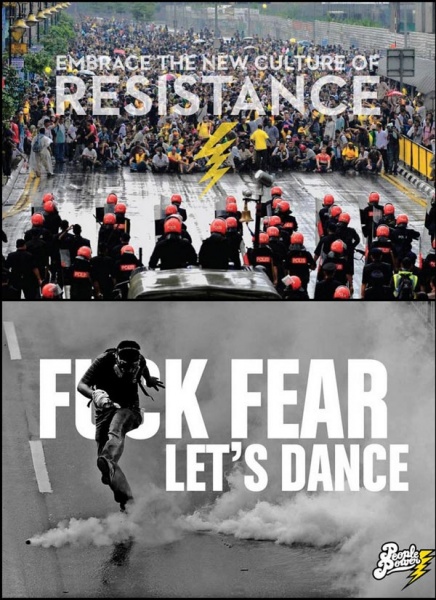Gita Lal documents the Bersih 2.0 rally in an article published on 19 July 2011 in TEMPO here.
A peaceful rally of more than 10,000 protestors in Kuala Lumpur last week ended in violence, bloodshed and hundreds of people arrested. The following is a witness account of that turbulent Saturday.

If tens of thousands of people defied government warnings and thronged the streets of Kuala Lumpur on Saturday, it was because Malaysians have been denied the basic right of a free and a fair election, an activist for the Malaysian Center for Constitutionalism and Human Rights (MCCHR) told TEMPO English Edition last Sunday.
Edmund Bon Tai Soon explained that the Bersih 2.0 coalition of civil society organizations had long been seeking electoral reforms in Malaysia. “To clean the electoral roll, to reform the postal ballot, to use indelible ink when voting, to have a longer campaign period of 21 days, to have free and fair access to the media during the elections, to strengthen our public institutions, and to stop corruption and ‘dirty’ politics,” said Edmund, detailing the demands of the protestors.
He said many Malaysians were unhappy that these simple demands would not be acted on, and that the Government was, instead, demonizing BERSIH and its supporters. “It was time to act.”
A Euphoric State
Over 1,600 people were detained during the protests and then released, as the crackdown on the opposition-backed demonstration continued to receive worldwide criticism, most of it aimed at Prime Minister Najib Razak. His long-ruling coalition, UMNO, had been unwilling to reform election laws ahead of the expected 2012 national polls.
On Sunday morning, Razak called for a special meeting, attended by thousands, including UMNO divisional heads and Malay non-governmental organizations. He reportedly appealed to all Malaysians to stop the demonstrations, calling them as not part of the Malay culture.
Edmund refuted this, arguing that peaceful assemblies was enshrined in Article 10 of the Malaysian Federal Constitution.
Separately, social activist Zain H.D. who took part in the historical protests, described the atmosphere as so euphoric, that he forgot to eat.
“We didn’t eat throughout the day. Many Malaysians were amused to see a 24-hour Seven Eleven convenience store closed. However, this was bad as some of us had little access to water, despite the sweating. The rain and the cooler temperature was a blessing,” Zain told TEMPO English Edition, adding that the tear gas from the police was a new experience to many people.
Coming Down Hard
When he was asked whether the Bersih 2.0 demonstration was a sign that things were changing at last in Malaysia, Edmund said that the group grew into a movement.
“BERSIH 2.0 grew into a movement because the Government came down hard on ordinary Malaysians. The Government was tripping over itself – using emergency laws to detain without trial, banning the yellow tee-shirt and picking off people from the streets if you were caught in possession of such tee-shirts,” Edmund said.
Separately, Zain H.D. coordinator of the “Yelloh Festival” said that to cheer up the protestors he tried to make people smile, surged people to carry yellow balloons, blowing bubbles and singing. He explained that he and five others were on their way to Jalan Puduraya in the city, when they heard that groups had gathered in both Puduraya and Petaling.
“Just as we were about to move, we bumped into about 500 UMNO Patriot demonstrators, before they were sprayed. We diverted our route and as we approached Bursa Malaysia, throngs of people ran toward us. They were not gassed but were definitely pursued by the police,” Zain said.
Going After The Weak
“First we retreated then, we turned back towards the Telekom Museum. When we were on Jalan Raja Chulan, approaching the junction of Jalan Tun Perak, we were met by the police.” He explained that as he got closer to them, the residue tear gas slowed down the crowd. That was when the police charged.
“As we retreated, they arrested some slow movers, including a 60-year old man, who was kicked as he was held by two other officers,” Zain said.
As the crowd retreated and the police formed a new line just across the street, they regrouped and move towards the protestors.
“The policemen were shocked and called for backup. They did not make it in time. Instead, the canisters came from their approaching backup. This group retreated to Jalan Bukit Nenas and eventually joined the main group at Jalan Puduraya. We then moved towards Jalan Petaling.”
He explained that as the crowds moved toward Maharajalela, getting much closer to the stadium, they merged yet with another group that was stationed in front of a road, that entered the stadium, blocked by police.
“At this point the crowd was really happy. It was a sea of people. At Maharajalela, there were a few speeches, a reading of prayers, and at 3.55pm, Haris Ibrahim from the Steering Committee told everyone to stick to our promise to disperse by 4pm peacefully.”
“After people left, as I walked away at 4.06 pm, police sprayed at the lingering crowd, where some were indeed taunting them. I take this as the final charge.”
Gita Lal

Educate the poor to vote only for Joe Publics who are worth no more than 200K, also see the pledge (with timeframes for each item to be determined) /questionairre below and ask your MP candidate or Assemblyman candidate, current MP or Assemblyman to sign with a cam taking down the signing in the presence of as many media reporters or people as possible :
http://www.facebook.com/photo.php?fbid=1914864390044&set=o.318515515322&type=1&theater